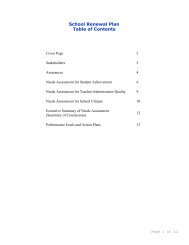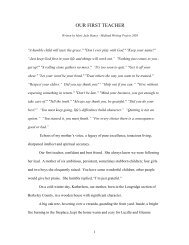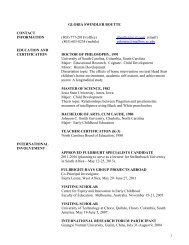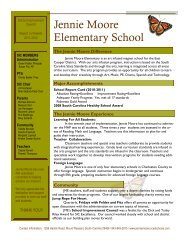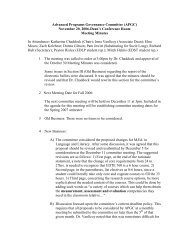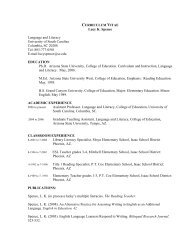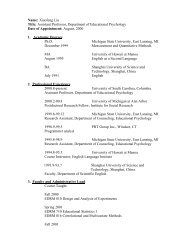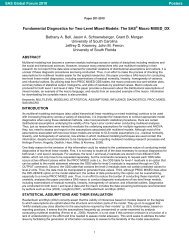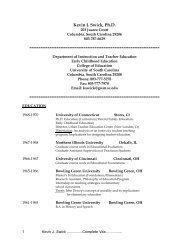Five Types of Quantitative Research
Five Types of Quantitative Research
Five Types of Quantitative Research
Create successful ePaper yourself
Turn your PDF publications into a flip-book with our unique Google optimized e-Paper software.
EDRM 700<br />
GREDLER<br />
<strong>Five</strong> <strong>Types</strong> <strong>of</strong> <strong>Research</strong><br />
Experimental <strong>Research</strong> – One or more aspects <strong>of</strong> a situation are manipulated under carefully<br />
controlled conditions and pre-selected outcomes are measured. Experimental studies,<br />
therefore, are intervention studies.<br />
Example: Does peer tutoring produce a greater understanding <strong>of</strong> science for sixth-grade<br />
students than small-group discussions?<br />
The researcher selects a sample <strong>of</strong> subjects and divides the sample into the number <strong>of</strong><br />
groups needed to test the hypotheses. In the above example, method <strong>of</strong> instruction is<br />
manipulated: A peer tutoring method is assigned to one-half <strong>of</strong> the students, and smallgroup<br />
discussion is assigned to the other half. At the end <strong>of</strong> six weeks, science<br />
achievement is measured using an appropriate instrument, and the two groups are<br />
compared.<br />
Other examples:<br />
Does client-centered therapy lead to higher satisfaction in adult clients than traditional<br />
therapy?<br />
Does an incident-based approach to discussing bullying raise the confidence level <strong>of</strong><br />
third-grade children?<br />
Key features:<br />
A planned intervention<br />
Two or more groups compared on a quantitative outcome<br />
Single-subject research – the study <strong>of</strong> the effects <strong>of</strong> an intervention on the behavior <strong>of</strong> one<br />
subject at a time; typically implemented in situations in which group designs are not<br />
appropriate. Observation is the typical method <strong>of</strong> data collection.<br />
Example: What are the effects <strong>of</strong> self-recording one’s actions on <strong>of</strong>f-task behavior for a<br />
high-school student with an attention-deficit hyperactivity disorder?<br />
Does a reinforcement program for hand-raising reduce the incidents <strong>of</strong> screeching to get<br />
adult attention in an autistic eight-year-old boy?
Key characteristics:<br />
A planned intervention<br />
One research subject only<br />
Measurement <strong>of</strong> a quantitative outcome<br />
Correlational <strong>Research</strong> – to determine whether, and to what degree, a relationship exists<br />
between two or more characteristics; sometimes used to make predictions about certain<br />
behaviors.<br />
Example: How well do prior grades and student self-directedness predict science<br />
achievement in middle school?<br />
The researcher selects a sample <strong>of</strong> subjects, obtains quantitative measures <strong>of</strong> the targeted<br />
characteristics, and calculates the relationship.<br />
Other examples: Is self-regulation related to math achievement in high school students?<br />
Is there a relationship between a mindful approach to problem solving and self-regulation<br />
in middle school students?<br />
Key features:<br />
NO INTERVENTION<br />
One group only<br />
At least two measurements<br />
Causal-comparative research – also referred to as “ex post facto” (after-the-fact research) –<br />
attempts to associate differences that already exist between or among groups <strong>of</strong><br />
individuals with differences in a particular characteristic. Unlike experimental research,<br />
the researcher does not create the difference between or among the groups. Instead, the<br />
difference is (a) a pre-existing characteristic that cannot be manipulated (age, gender) or<br />
(b) a characteristic that cannot be manipulated ethically or easily (teaching style).<br />
Example: Do 10-year-olds <strong>of</strong> different gender differ in linguistic ability?<br />
Two groups <strong>of</strong> subjects that differ on an existing characteristic are measured on some<br />
attitude, skill, or other characteristic to determine if there are differences.<br />
Note: Interpretations <strong>of</strong> causal-comparative research are limited; the researcher cannot state that<br />
the identified factor is the cause – only that there is a difference between groups.
Other examples:<br />
Do middle-school teachers behave differently to students <strong>of</strong> different genders?<br />
Do boys who attended kindergarten score higher on social adjustment than boys who did<br />
not attend kindergarten?<br />
Key features:<br />
NO INTERVENTION<br />
A pre-existing characteristic is the focus <strong>of</strong> the research<br />
Two or more groups<br />
Measurement <strong>of</strong> a quantitative outcome<br />
Descriptive or Survey <strong>Research</strong> – information is collected from a sample in order to describe<br />
some aspects or characteristics <strong>of</strong> the larger group to which the surveyed individuals<br />
belong.<br />
Example: What are the views <strong>of</strong> beginning teachers in District X about the mentoring<br />
system for new teachers?<br />
The researcher selects a sample <strong>of</strong> subjects, administers the survey, and, typically, reports<br />
the percentages <strong>of</strong> respondents who respond differently to the questions.<br />
Other examples:<br />
How do parents in school district Y feel about the middle-school counseling program?<br />
What are high school teachers’ views <strong>of</strong> the dimensions <strong>of</strong> effective school leadership?<br />
Key features:<br />
NO INTERVENTION<br />
A defined group<br />
Administration <strong>of</strong> surveys or interviews<br />
Typically, calculation <strong>of</strong> percentages <strong>of</strong> respondents on the answers





